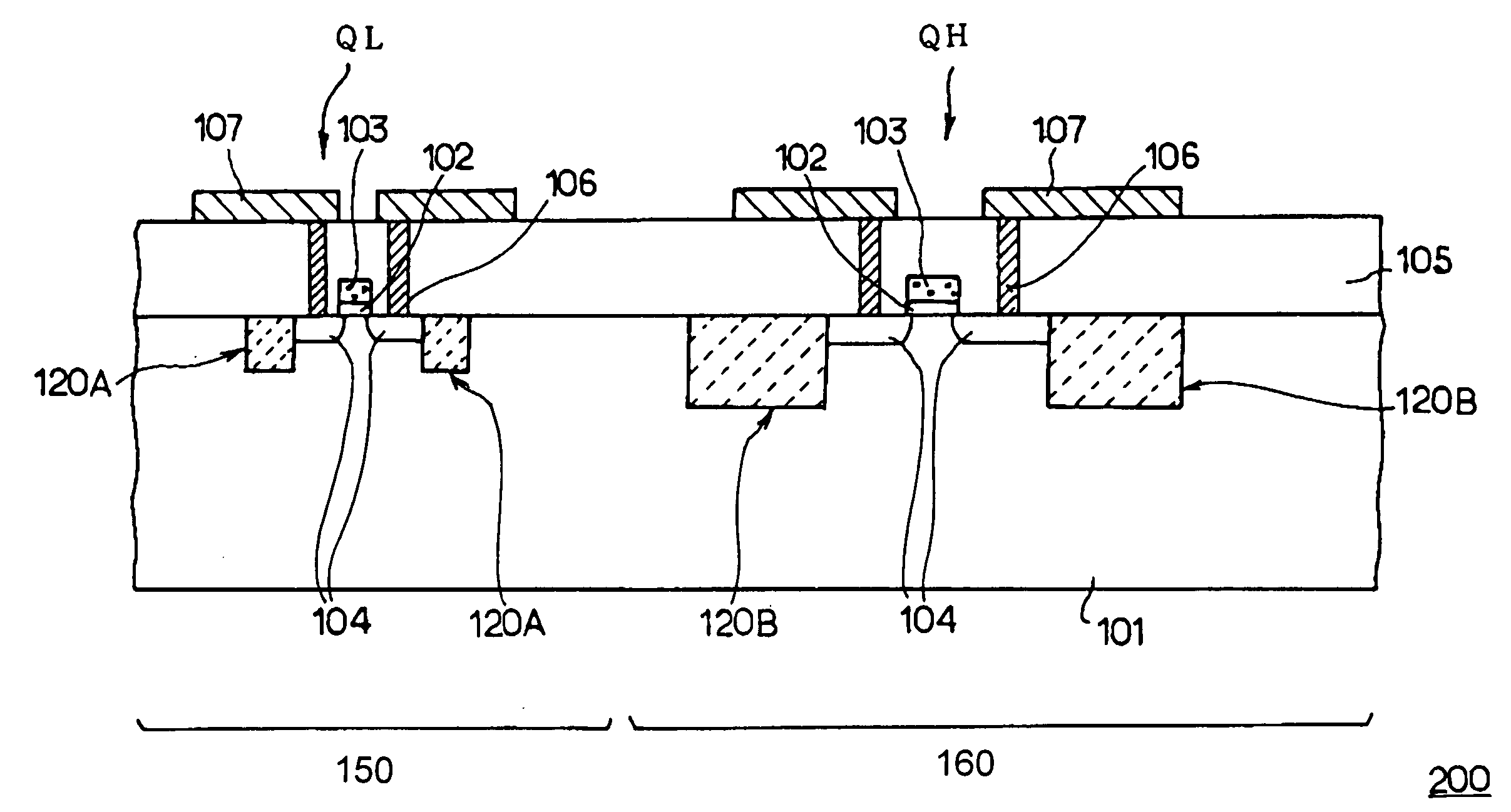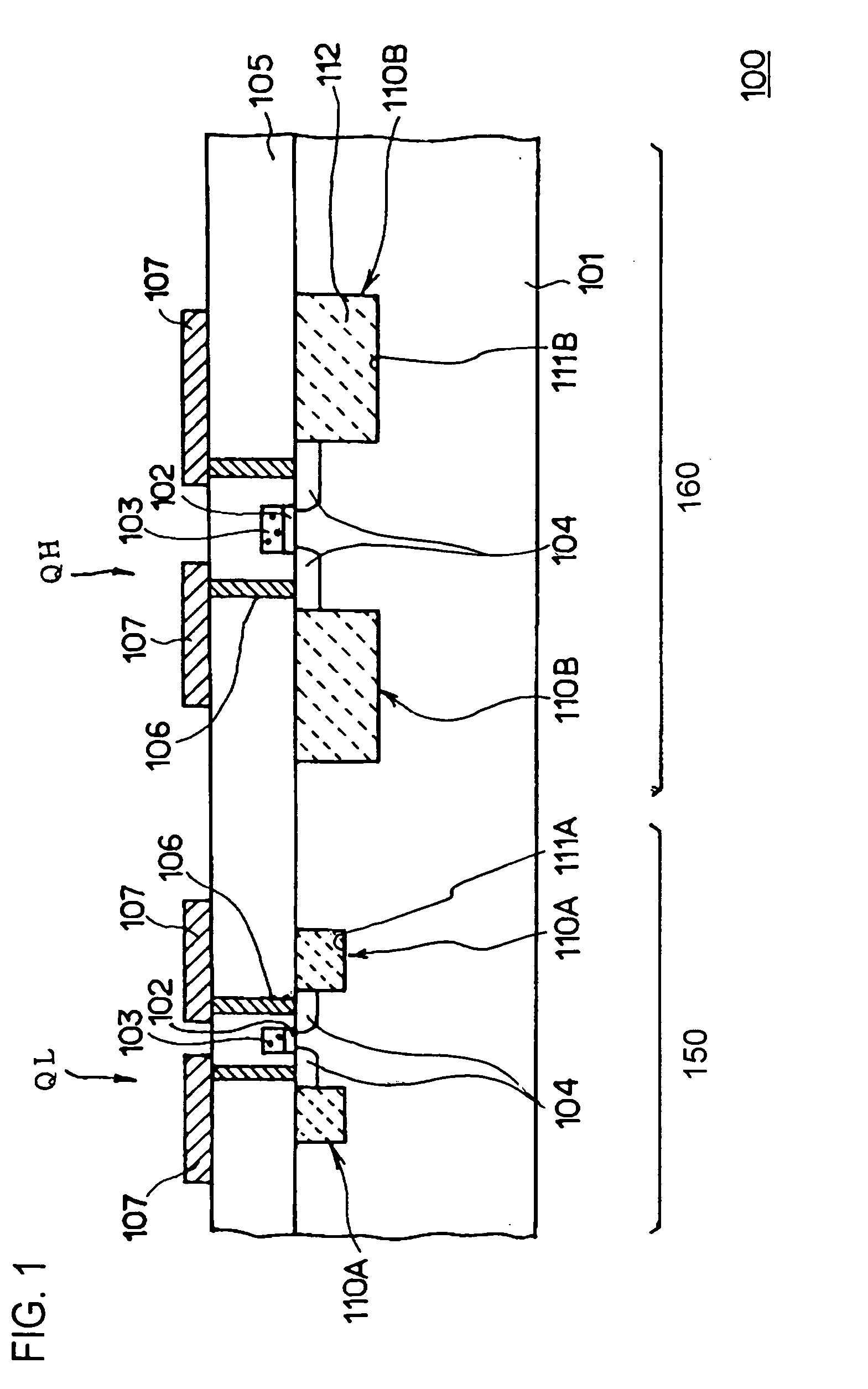Method for manufacturing semiconductor device
- Summary
- Abstract
- Description
- Claims
- Application Information
AI Technical Summary
Benefits of technology
Problems solved by technology
Method used
Image
Examples
first embodiment
[0035] A semiconductor device according to the present embodiment will be described in reference to the annexed figures as follows. FIG. 1 is a schematic cross-sectional view of a semiconductor device according to the present embodiment. The present embodiment illustrates an example of applying the present invention to a memory device 100, and a peripheral region 160 is provided in a portion of a silicon substrate 101 that is the semiconductor substrate, and a cell region 150 composed of a memory cell that is the cell device is provided in other portion thereof. A higher breakdown voltage resistance MOS transistor QH, which is the high breakdown voltage resistance device, is formed in the peripheral region 160, as a device that is driven at a source voltage equivalent to or higher than a source voltage for a device (not shown in the drawings) in the cell region 150 driven at a lower source voltage, and a cell MOS transistor QL is formed as a device that is driven at lower source vol...
second embodiment
[0046] Next, a semiconductor device according to the present embodiment will be described in reference to the annexed figures as follows. FIG. 4 is a schematic cross-sectional view of a semiconductor device according to the present embodiment, and illustrates an example of applying the present invention to a memory device 200 similarly as in the first embodiment. As describing with assigning the same numeral for the equivalent element shown in the first embodiment, a peripheral region 160 is provided in a portion of a silicon substrate 101 and a cell region 150 composed of a memory cell is provided in other portion thereof. A higher breakdown voltage resistance MOS transistor QH is formed in the peripheral region 160, as a device that is driven at higher source voltage, and a cell MOS transistor QL is formed in the cell region 150, which is driven at lower source voltage than that of higher breakdown voltage resistance of MOS transistor QH. The structures of these MOS transistors ar...
third embodiment
[0058]FIGS. 7A to 7D are cross sectional views, showing the process sequence of the method for manufacturing the memory device shown in FIG. 1 according to the present embodiment, which is manufactured by a different process from the process described in the first embodiment. First, as shown in FIG. 7A, a thin silicon oxide film 131 having a thickness of about 10 nm is formed on the surface of the silicon substrate 101 via a first oxidation process, and a silicon nitride film 132 having a thickness of about 150 nm is formed thereon via a nitridation process. Then, a first photo resist pattern 133A having openings disposed only in the locations for forming STI in the cell region 150 is formed on the silicon nitride film 132. The opening widths of the windows in the first photo resist pattern 133A are about 150 nm. Then, the silicon nitride film 132 and the silicon oxide film 131 are sequentially etched off thorough a mask of the first photo resist pattern 133A via a plasma etching to...
PUM
 Login to View More
Login to View More Abstract
Description
Claims
Application Information
 Login to View More
Login to View More - R&D
- Intellectual Property
- Life Sciences
- Materials
- Tech Scout
- Unparalleled Data Quality
- Higher Quality Content
- 60% Fewer Hallucinations
Browse by: Latest US Patents, China's latest patents, Technical Efficacy Thesaurus, Application Domain, Technology Topic, Popular Technical Reports.
© 2025 PatSnap. All rights reserved.Legal|Privacy policy|Modern Slavery Act Transparency Statement|Sitemap|About US| Contact US: help@patsnap.com



